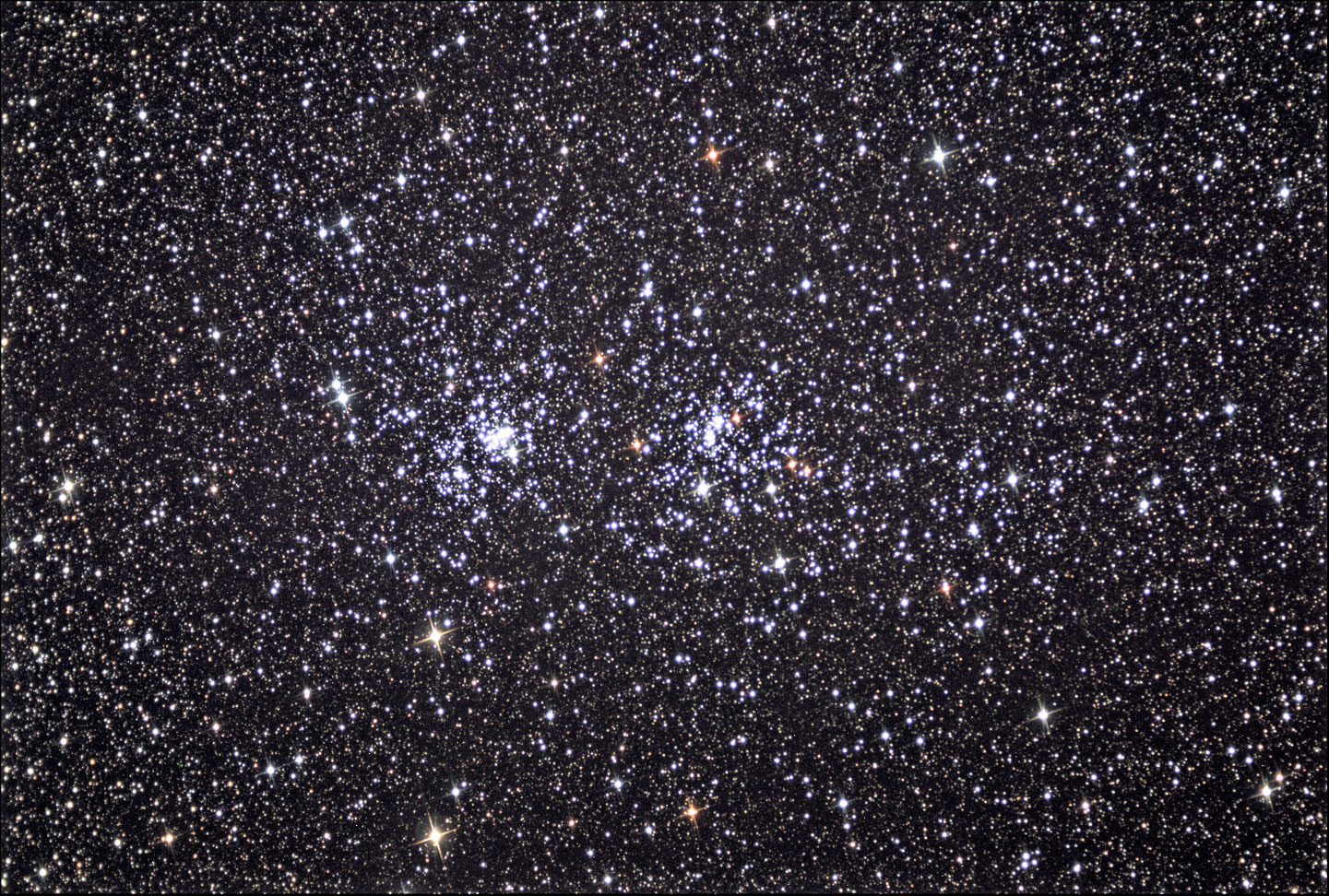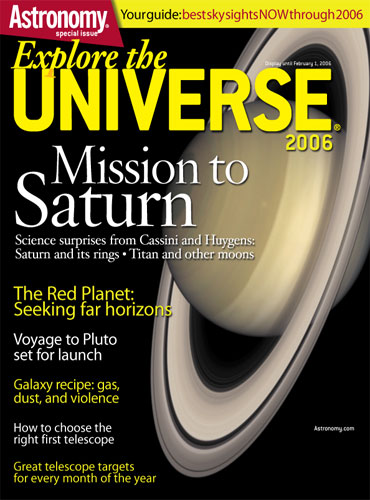
Perseus Double Cluster NGC 869 & NGC 844

Image Credit: Fred Calvert / Adam Block / NOAO /AURA / NSF / KPNO
Taken December 4, 2004 @ Kitt Peak National Observatory, Arizona (USA)
 The
famous double cluster in Perseus was known in antiquity (probably even pre-historically), and first cataloged by the Greek philosopher and astronomer
Hipparchus.
The
famous double cluster in Perseus was known in antiquity (probably even pre-historically), and first cataloged by the Greek philosopher and astronomer
Hipparchus.
Both clusters are situated in the Perseus OB 1 association, and also only a few hundred light-years apart, at a distance of over 7000 light years.
They are both quite young: h is listed at 5.6, chi at 3.2 million years (Sky Catalog 2000) their hottest main sequence stars are of spectral type O & B.
They are approaching us at 22 (h) and 21 (chi) km/sec, respectively.
This image of the Double Cluster was use in the "Beautiful Universe" picture section of "Explore the UNIVERSE 2006" published by Astronomy Magazine.
Image & Caption on page 106
THE DOUBLE CLUSTER (NGC 869 AND NGC 884) lies near the famous "W" of Cassiopeia the Queen. These clusters were cataloged by the Greek philosopher Hipparchus in 130 B.C. Both clusters lie approximately 7,000 light-years away. (3.2-inch Tele Vue 76 apochromatic refractor at f/6.3, SBIG ST-10XME CCD camera, RGB image with 15-minute exposures in red, green, blue) Fred Calvert / Adam Block / NOAO / AURA / NSF, Kitt Peak National Observatory
Stellar Spectral Types :
Stars are classified by their spectra (the elements that
they absorb) and their temperature. There are seven main types of stars. In
order of decreasing temperature, O, B, A, F, G, K, and M.
O and B stars are uncommon but very bright; M stars are common but dim.
Type "O" & "B" type stars have very short life cycles, only about one million years compared to a "G" type star (like our sun) who life cycle is around 9 billion years.
By the way, not to worry, were only about 4.5 billion years into our sun's life, with 4.5 billion years, give or take a few billion to go.
Plenty of time to do everything in life you ever wanted to do.
The commonly used mnemonic for the sequence of these classifications is "Oh
Be A
Fine Girl,
Kiss Me".
| Star Type | Color | Approximate Surface Temperature | Average Mass (The Sun = 1) | Average Radius (The Sun = 1) | Average Luminosity (The Sun = 1) | Main Characteristics | Examples |
|---|---|---|---|---|---|---|---|
| O | Blue | over 25,000 K | 60 | 15 | 1,400,000 | Singly ionized helium lines (H I) either in emission or absorption. Strong UV continuum. | 10 Lacertra |
| B | Blue | 11,000 - 25,000 K | 18 | 7 | 20,000 | Neutral helium lines (H II) in absorption. |
Rigel Spica |
| A | Blue | 7,500 - 11,000 K | 3.2 | 2.5 | 80 | Hydrogen (H) lines strongest for A0 stars, decreasing for other A's. | Sirius, Vega |
| F | Blue to White | 6,000 - 7,500 K | 1.7 | 1.3 | 6 | Ca II absorption. Metallic lines become noticeable. | Canopus, Procyon |
| G | White to Yellow | 5,000 - 6,000 K | 1.1 | 1.1 | 1.2 | Absorption lines of neutral metallic atoms and ions (e.g. once-ionized calcium). | Sun, Capella |
| K | Orange to Red | 3,500 - 5,000 K | 0.8 | 0.9 | 0.4 | Metallic lines, some blue continuum. | Arcturus, Aldebaran |
| M | Red | under 3,500 K | 0.3 | 0.4 | 0.04 (very faint) |
Some molecular bands of titanium oxide. | Betelgeuse, Antares |
Equipment used to take this image:
Televue (480mm f6.3) SBIG ST10XME w Color Filter Wheel Piggybacked to a Mead 16" LX200
Exposure Data:
LRGB
Luminance = 15 minutes (synthetic) binned 1 X 1
Red = 15 minutes binned 1 X 1
Green = 15 minutes binned 1 X 1
Blue = 15 minutes binned 1 X 1
Back to December 2004 Run Home